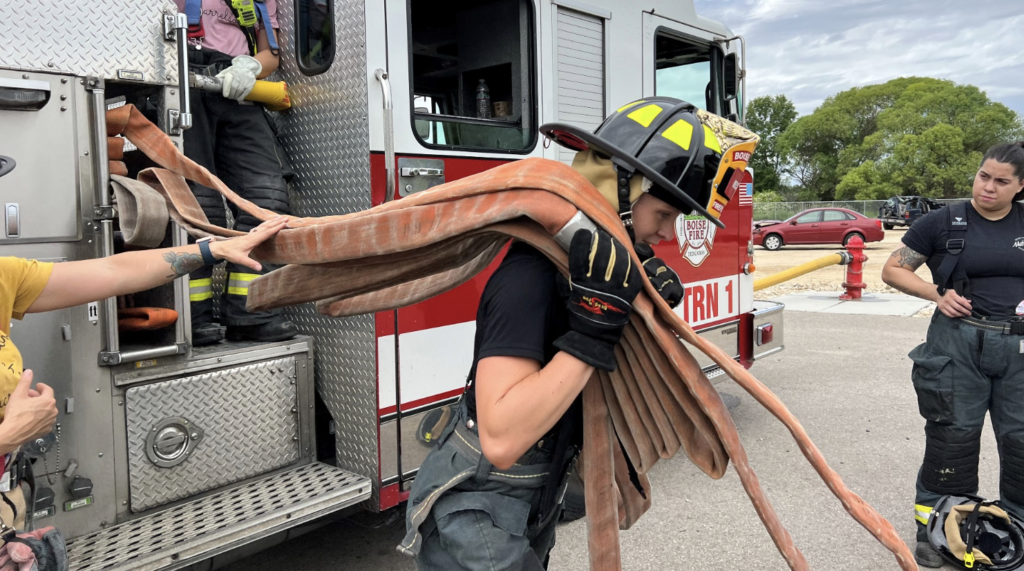Summer 2024
The reality of the job and the importance of holistic training

As firefighters get further into their careers, they start to see and feel the effects of stress. The interrupted sleep on shift, the mental effects of traumatic calls, and the sustained hypervigilance of the Central Nervous System (CNS). When on a shift, we are constantly on edge and ready for the unknown – constant fight or flight mode. These are all things we don’t think about as firefighters, but they can have critical and lasting effects on our lives.
We may not feel the hypervigilance of the CNS while on shift, but it is real. We switch modes the night before, or on the way to the station. This work mode is constant throughout the entire shift. We’re in work mode for 24 to 48 hours and if we work overtime up to 72 hours. Most professionals’ work modes don’t include such acute and constant activation of the CNS.
This acute and sustained activation of the CNS has a huge impact on us as humans. We aren’t wired to be in this state of constant fight or flight (hypervigilance) for so long. Our bodies are built to have this be a quick state, for hunting prey or evading predators. Our CNS is built to work intensely to get us out of a bad situation and then recover from it and return to homeostasis quickly. Unfortunately, as first responders, our CNSs get abused. This state of hypervigilance increases hormonal response to cortisol, adrenaline, norepinephrine, etc. There is a cascade effect, and over time it takes a nasty toll on the body. What’s worse is that typically a firefighter’s CNS is not only activated for their full 24-48 hour shift but begins being activated well before shift (as we get into work mode) and continues long after the shift is over.
So, what can we do to help mitigate the effects of our shift work, CNS hypervigilance, and the impact of the job on us as firefighters? The answer: many of the holistic basics we already know about – eating healthy natural foods, having a sleep routine for more restorative sleep, getting a full 7-9 hours of sleep each night, and exercising. However, beware – working out can also put CNS stress on a person, exacerbating the situation.
The Need for a Holistic Approach
A holistic training regimen integrates various components of fitness, including strength, endurance, flexibility, mobility, and mental resilience. This comprehensive approach ensures that firefighters are not only physically prepared but also mentally and emotionally equipped to handle the rigors of their job. They help bring us down, back to homeostasis, after a shift, instead of keeping us spiked.
- Strength Training: While high-intensity resistance training focuses on building muscle mass, endurance, and power, a holistic approach incorporates functional strength training. This includes exercises that mimic real-life movements, improving overall job performance. Research has shown that functional training enhances both muscle strength and coordination, leading to better performance in physically demanding tasks (Behm & Sale, 1993).
- Endurance Training: Cardiovascular fitness is crucial for firefighters, who must often work in high-stress, high-stamina situations. Instead of relying solely on HIIT, incorporating steady-state cardio in addition to interval training can build endurance without causing excessive strain on the body or CNS. Studies have demonstrated that a combination of steady-state and interval training can improve aerobic capacity and reduce cardiovascular risk factors (Garber et al., 2011).
- Flexibility and Mobility: Flexibility and mobility are often overlooked in traditional high-intensity training programs but are vital for preventing injuries and maintaining functional movement patterns. Incorporating stretching, yoga, and dynamic mobility exercises into a training program can enhance flexibility, reduce injury risk, and improve overall performance (Page et al., 2012).
- Mental Resilience: The psychological demands of firefighting are immense. Training programs should include components that build mental toughness, stress management, and emotional resilience. Techniques such as mindfulness, meditation, and mental conditioning can prepare firefighters to handle the mental stress of their jobs, enhancing overall well-being and performance (Jha et al., 2010).
Implementing Holistic Training
Implementing a holistic training program requires a balance of evidence-based practices tailored to the specific needs of firefighters. Here are some key components to consider:
- Periodization: This involves planning training cycles to optimize performance and recovery. Periodization can prevent overtraining by varying the intensity and volume of workouts, ensuring that firefighters remain in peak condition throughout the year (Kraemer et al., 2002).
- Recovery Strategies: Incorporating adequate recovery strategies such as active recovery, proper nutrition, hydration, and sleep hygiene is critical. Recovery is an integral part of a holistic training program, helping to mitigate the risk of injury and burnout (Mujika & Padilla, 2001).
- Cross-Training: Engaging in different forms of exercise can improve overall fitness and prevent overuse injuries. Cross-training can include activities such as swimming, cycling, and even recreational sports, providing a well-rounded fitness base (Tanaka & Swensen, 1998).
- Individualization: Tailoring training programs to the individual needs and capabilities of each firefighter is essential. This personalized approach ensures that each firefighter can progress at their own pace, addressing specific weaknesses and building on strengths (Haff & Triplett, 2015).
The reality of the job as a firefighter is that we are constantly dealing with stress – from the physical demands to the mental strain and the continuous activation of our CNS. The traditional high-intensity training methods, while beneficial in some respects, may not be the best fit for our unique needs. A holistic approach to training recognizes that firefighters need more than just brute strength or cardiovascular endurance in zone 5. They require a balanced fitness program that enhances all aspects of their physical and mental capabilities, ensuring they are fully prepared to meet the demands of their profession.
» ALSO SEE: The Recovery Standard Project
This approach not only improves performance on the job but also promotes long-term health and well-being, reducing the risk of injury and burnout.



